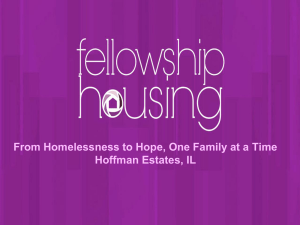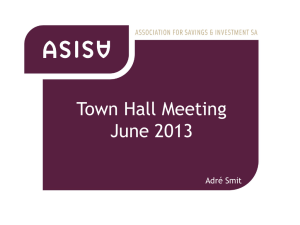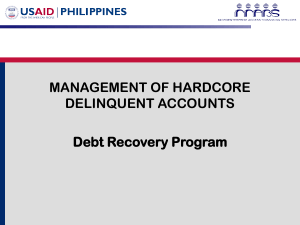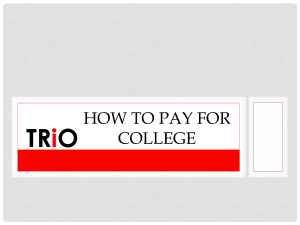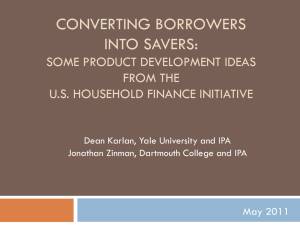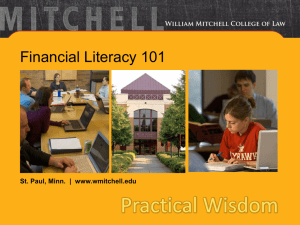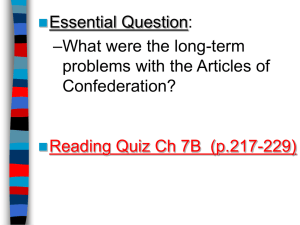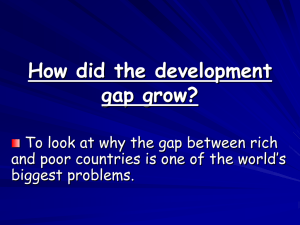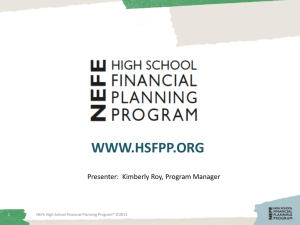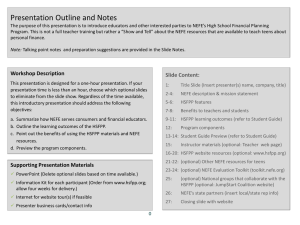nefe unit 4 ppoint
advertisement
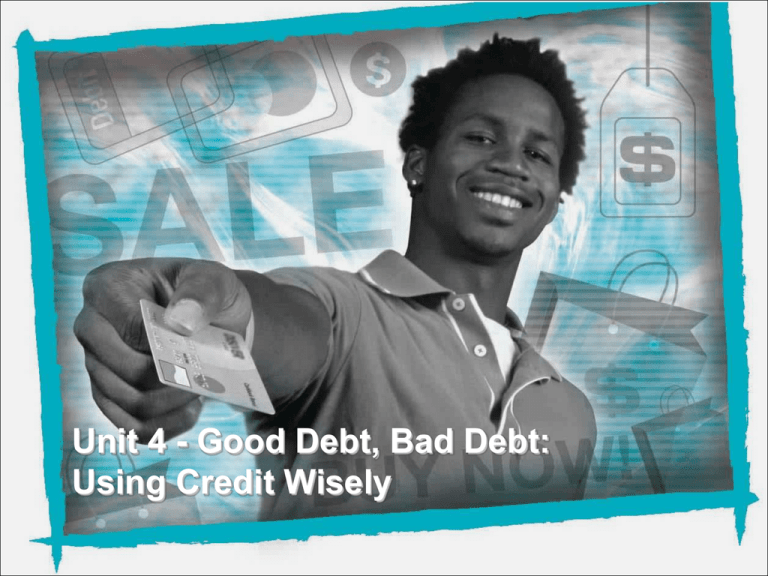
NEFE High School Financial Planning Program Unit 4 – Good Debt, Bad Debt: Using Credit Wisely Unit 4 - Good Debt, Bad Debt: Using Credit Wisely NEFE High School Financial Planning Program Unit 4 – Good Debt, Bad Debt: Using Credit Wisely Credit Facts • Nearly 33% of teens owe money to either a person or company, with an average debt of $230. • About 26% of teens ages 16-18 already have more than $1,000 in debt. • 30% of teens say they understand how credit card interest and fees work. • 36% of teens say they know how to establish good credit. 4-A NEFE High School Financial Planning Program Unit 4 – Good Debt, Bad Debt: Using Credit Wisely Top 10 Questions to Ask Before Signing on the Dotted Line 10.All things considered, is using 1. Can 6. Do I Ireally affordneed to pay thisthe item monthly right now, or credit worth it for this purchase? can I wait? payments? 7. 2. 3. 8. 4. 9. 5. 4-B-2 4-B-3 4-B-1 WhatI will Can qualify happen for credit? if I don’t make the payments time? rate (APR) on this What is theoninterest card? will be the extra cost of using What credit? Are there additional fees? What will I have give uppayment, to pay forand it? How much is thetomonthly when is it due? 1 2 NEFE High School Financial Planning Program Unit 4 – Good Debt, Bad Debt: Using Credit Wisely The Language of Credit • Credit is the amount of money or something of value that is loaned on trust with the expectation it will be repaid later to lenders. • Types of Credit – Borrow up to a predetermined limit (i.e., credit card) – Borrow cash to be repaid by a specific date – Borrow money for a major purchase to be repaid in regular payments over time, typically monthly (i.e., car loan, home mortgage) 4-C-1 1 of 4 NEFE High School Financial Planning Program Unit 4 – Good Debt, Bad Debt: Using Credit Wisely The Language of Credit • Debt is the entire amount of money you owe to lenders. • APR (Annual Percentage Rate) is the total cost to use credit in a year. • Term is how long you have to repay a loan, often expressed in months. • Fees are charged to use credit. Examples: Annual Credit Card Fee, Loan Origination Fee, Over-the-Limit Fee 4-C-2 2 of 4 NEFE High School Financial Planning Program Unit 4 – Good Debt, Bad Debt: Using Credit Wisely The Language of Credit • Credit History is a record of your behavior related to borrowing and repaying loans. • Credit Report is a detailed record of your personal credit and financial transactions. • Credit Score is a rating used by credit reporting companies to help lenders decide whether and/or how much credit can be extended to a borrower. 4-C-3 3 of 4 NEFE High School Financial Planning Program Unit 4 – Good Debt, Bad Debt: Using Credit Wisely The Language of Credit • Universal Default allows a credit card company to increase your interest rate if you make just one late payment. • Bankruptcy is a legal process to get out of debt when you can no longer make all your required payments. 4-C-4 4 of 4 NEFE High School Financial Planning Program Unit 4 – Good Debt, Bad Debt: Using Credit Wisely Types of Credit 4-D Installment Credit Revolving Credit • Fixed payments • Set period of time to repay • Set or varying interest rates • Car loans and home loans are typical examples. • No stated payoff time • Limit to credit • Minimum monthly payments • Interest rates vary or not • Finance charges • Credit cards most typical example NEFE High School Financial Planning Program Unit 4 – Good Debt, Bad Debt: Using Credit Wisely Sources of Credit • • • • • • • 4-E Banks Credit Unions Department Stores Automobile Dealers Oil Companies (for gas stations) Federal Government (for student loans) Others? NEFE High School Financial Planning Program Unit 4 – Good Debt, Bad Debt: Using Credit Wisely WHEN YOU BUY “STUFF” You bought “STUFF” with your credit card. In fact, you bought $500 worth of “STUFF” with your credit card. Your APR is 18%. You plan to pay $10 a month to pay it off. You will pay $431 in interest Final cost of your purchases = $931.40 And it will take SEVEN YEARS and NINE MONTHS 4-F 1 NEFE High School Financial Planning Program Unit 4 – Good Debt, Bad Debt: Using Credit Wisely How Long Will It Take??? You owe $3,000. APR = 18% Payment: 4% of current balance Finance Charge $1715.69 Total cost of original $3,000 loan = $4715.69 And it will take nearly 11 YEARS to pay off! After you’ve made the last payment, will what you purchased still be around??? 4-G 1 NEFE High School Financial Planning Program Unit 4 – Good Debt, Bad Debt: Using Credit Wisely The Cost of Using Credit $700 for a Game System APR = 24% Payment: 4% of current balance Finance Charge $550.04 Your CD player REALLY cost $1,250.04 And it will take over 7 years to pay off! After you’ve made the last payment, will your CD player still be around??? 4-H 1 NEFE High School Financial Planning Program Unit 4 – Good Debt, Bad Debt: Using Credit Wisely The Cost of Using Credit Interest Rate = 24% Payment = 4% of Current Balance 4-I BALANCE TIME TO PAY OFF INTEREST CHARGED TOTAL COST $2,000 11 YEARS 6 MONTHS $1,850 $3,850 $6,000 16 YEARS 1 MONTH $5,850 $11,850 $10,000 18 YEARS 2 MONTHS $9,850 $19,850 1 2 3 NEFE High School Financial Planning Program Unit 4 – Good Debt, Bad Debt: Using Credit Wisely The Cost of Using Credit $3,000 Charged to Credit Account APR = 21% Payment: 4% of current balance Finance Charges $2,220.57 Annual Credit Card Fee: $65 Paying the minimum, it will take you 11 YEARS and 11 MONTHS to pay off your debt. 4-J 1 You Owed $3,000 but You Paid $6,065+ Includies annual fees NEFE High School Financial Planning Program Unit 4 – Good Debt, Bad Debt: Using Credit Wisely 1 of 2 Financial Consequences of Debt • Could put you in a state of overspending and perpetual debt, where you get used to carrying a balance and paying extremely high interest rates. • Could adversely affect your credit rating, making it harder to get loans when you really need them. 4-K-1 1 of 2 NEFE High School Financial Planning Program Unit 4 – Good Debt, Bad Debt: Using Credit Wisely 2 of 2 Financial Consequences of Debt What if you took the $120 monthly payment in the last example and INVESTED $120 a month for the 12 years it took to pay off the $3,000 debt, and your investment got an 8% rate of return? Instead of $6,000 paid out for $3,000 worth of “stuff”, your $120 monthly investments would amount to $28,799 in your pocket! 4-K-2 2 of 2 NEFE High School Financial Planning Program Unit 4 – Good Debt, Bad Debt: Using Credit Wisely The Four “Cs” of Credit Collateral Capital Capacity Character 4-L NEFE High School Financial Planning Program Unit 4 – Good Debt, Bad Debt: Using Credit Wisely How Credit Scores Are Determined – FICO Scores • Your payment history – Information about how you make your payments on credit cards, store accounts, car loans, finance companies, mortgages – Accounts in collection or past due, and how long past due – Information in public records, such as bankruptcy, judgments, liens, wage attachments or child support 4-M-1 1 2 3 NEFE High School Financial Planning Program Unit 4 – Good Debt, Bad Debt: Using Credit Wisely How Credit Scores Are Determined • Your overall debt – How much you owe on all your accounts – How much credit you have available to use • Your credit account history – When you opened and used each of your accounts – How recently you applied for new credit – Recent good credit history following past payment problems 4-M-2 1 2 3 NEFE High School Financial Planning Program Unit 4 – Good Debt, Bad Debt: Using Credit Wisely How Credit Scores Are Determined • Types of Credit – The different types of credit accounts you have – The total number of accounts you have 4-M-3 1 2 3 NEFE High School Financial Planning Program Unit 4 – Good Debt, Bad Debt: Using Credit Wisely Get and Keep a Good Score • • • • Make sure your credit report is accurate. Pay all your bills on time. Apply for credit only when you need it. Lower the balances on all your credit accounts. • Pay off debt rather than moving it around. 4-N NEFE High School Financial Planning Program Unit 4 – Good Debt, Bad Debt: Using Credit Wisely Protect Yourself Against Inaccurate Credit Reports • Get a copy of your free credit reports from all credit rating agencies. • Examine it thoroughly. • If you find something that is incorrect, ask the agency to investigate the information. • If that doesn’t resolve the issue, you can attach a short statement to your credit report. 4-O NEFE High School Financial Planning Program Unit 4 – Good Debt, Bad Debt: Using Credit Wisely Rule of Thumb 10% Pay Off Debt 20% Save or Invest 70% Living Expenses 4-P

